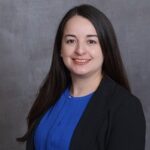Volume 36 Number 1 | February 2022
Letycia C. Nuñez Argote, MPH, CPH, MLS(ASCP)CM, ASCLS Diversity Advocacy Council Vice Chair

The ASCLS Diversity Advocacy Council has a commitment to “promote inclusivity, communication, and cooperation among medical laboratory professionals, and to promote and encourage a social and fraternal atmosphere for members.”1 While this is a catalyst for what we must accomplish, it leaves the more elusive how and why open for all of us to address.
The Way We Approach Laboratory Education

Although organizations have started to see a need for cultural sensitivity training and similar initiatives highlighting diversity, not everyone is prepared to receive this information in an actionable and productive way. Training modules at work or in our academic institutions rely on unconscious bias training to bring awareness to employees on the harms that entrenched beliefs can have on others. But knowing I hold a bias does not automatically create a deeper understanding of how and why these biases impact my behavior, judgment, and decisions toward a patient or a colleague. A one-off seminar or sitting by myself at my computer completing an online module is a start. Having a space where I can continuously challenge my assumptions, where I can interact with others who are also attempting similar growth, is even better.
A potential avenue would require that laboratory professionals engage with DEI content as part of our training and continued certification. It would be my hope that our certifying bodies set the example by creating a standard for regular DEI training. Instead of the material included as a two-hour session in “that one class,” it would become a specific part of the curriculum with an assigned number of credit hours. And that just as many of us have to report every three years that we know about hematology and laboratory safety, we should also specifically show that we are achieving competency on DEI issues.
“We need space and practice to work out the rough edges in our discourse, and we need to remove the need for a perfect interaction every time so long as it is productive.”
Constructive Dialogue and Creating Connection
Another very challenging but needed approach would be to embed the principles of DEI into every aspect of our lives, into our personal and work relationships, through dialogue. Talking about DEI is tricky because there is a social cost to speaking up in an environment that is not primed for the interaction. But it is dangerous and damaging to ignore and quietly wish away the interpersonal problems that stem from not voicing our concerns when we experience harmful behavior toward ourselves or see it happen to our colleagues.
“Silence in the face of injustice not only kills any space for productive conversations, but also allows cancerous ideas to grow.”2 To promote and sustain dialogue and engagement, we need to consider how we talk to each other and that many problems in our relationships are about ideas and not people. But how do we de-escalate in a productive way?
One way is “intense dialogue training,” which can help us overcome challenges associated with our ideas and beliefs.3 The Courageous Conversation Protocol provides a framework for brave encounters that require participants to experience discomfort, stay engaged, speak their truth, and expect and accept non-closure. This activity encourages us to approach our interactions from a place of curiosity rather than judgment. When engaged in dialogue, we should tell ourselves: “I don’t know your history and where you come from and where these beliefs come from, and that is okay. Let me ask.”
We need space and practice to work out the rough edges in our discourse, and we need to remove the need for a perfect interaction every time so long as it is productive. PRISM: Pride · Respect · Inclusion · Support · Momentum is a needed space that invites dialog and interaction with topics that may be uncomfortable but are necessary to address the current needs of both clinical laboratories and society at large. Some of the activities that have already taken place include sessions on allyship and health disparities. This year for Book Discussions, we are reading Demanding More: Why Diversity and Inclusion Don’t Happen and What You Can Do About It, by Sheree Atcheson.
In the wise words of my dear friend Dana P. Baker, “diversity doesn’t happen by itself, and it doesn’t happen overnight.”4 We have to be intentional. I want to see more hospitals, education institutions, and professional organizations like ASCLS moving forward with steps to provide support and understanding for our diverse learners, workforce, and patients. By defining itself as “an organization where all persons can engage and participate in a meaningful way empowering everyone to grow and learn,” ASCLS shows commitment to deliberately and purposefully promoting a more equitable workplace for all laboratory professionals.1
Special thanks to Justin Hanenberg, MS, MLS(ASCP)CM, for the thought-provoking conversation that inspired this article.
References
- American Society for Clinical Laboratory Science (ASCLS). Diversity Advocacy Council. Publication date unavailable. Updated 2019. https://connect.ascls.org/dac/home. Accessed December 5, 2021.
- Okwerekwu JA. What happened when I talked about what others ignore–racism in medicine. Stat News. April 27, 2016. https://www.statnews.com/2016/04/27/racism-medicine-lessons/. Accessed December 5, 2021.
- Acosta D, Ackerman-Barger K. Breaking the Silence: Time to Talk About Race and Racism. Acad Med. 2017;92:285–288.
- Swails K. The Importance of a Diverse Laboratory. Critical Values. 2019;12(3):20-22.
Letycia Nuñez-Argote is a Clinical Assistant Professor in the Department of Clinical Laboratory Sciences at the University of Kansas Medical Center in Kansas City, Kansas.